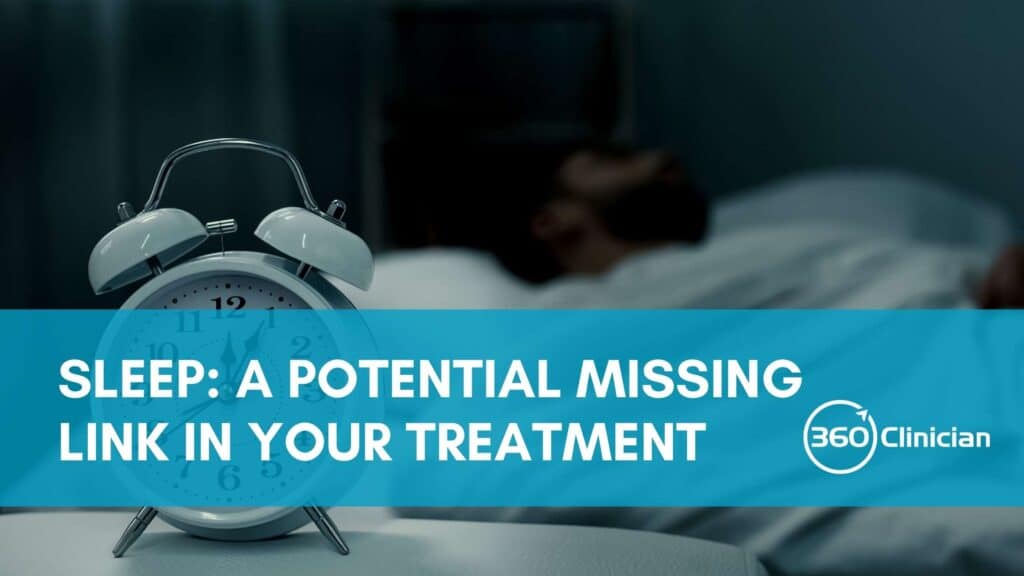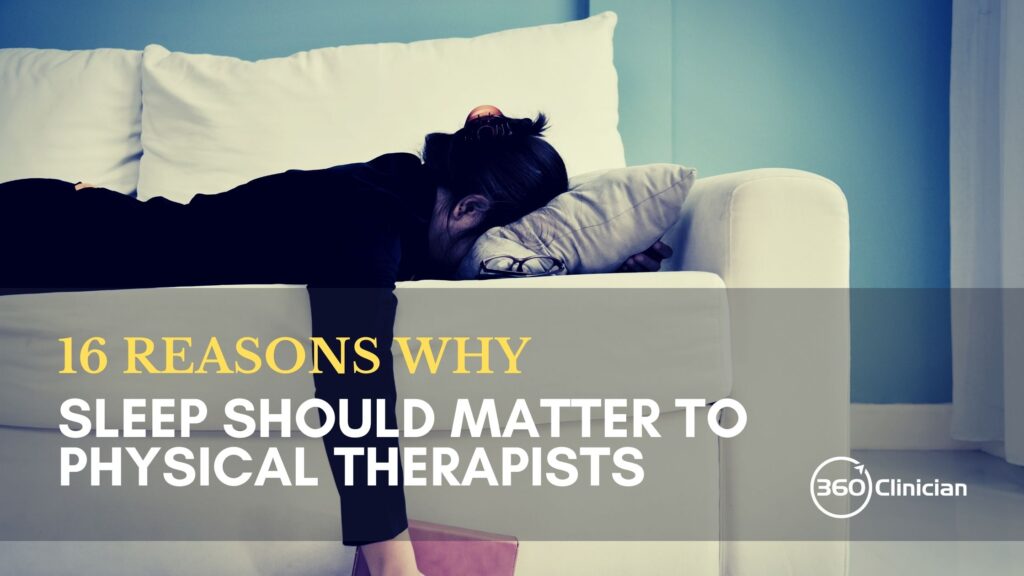[This article originally was published on the CPA Pain Science Division Blog here]
Why We Need to Take Sleep More Seriously
As physiotherapists who treat patients with persistent pain, it’s important not to shy away from exploring the role of sleep in recovery and wholeness. It’s very common for patients with chronic pain to experience disrupted sleep; the effects within the body are many. We spend a third of our lives sleeping and if we are serious about incorporating a biopsychosocial approach to our assessment and treatment, we must look to incorporate sleep into our treatment paradigm.
The impacts of poor sleep on health are many including general health impacts such as an increased risk of diabetes, obesity, mortality, among others. As physiotherapists treating patients with pain, I would like to highlight for you the impact of sleep on pain and inflammation.
The Impact of Poor Sleep on Pain
The more you read, the more apparent the link between pain and sleep deprivation becomes. Statistics show that 50-80% of people with chronic pain have sleep dysfunction. And I’m sure your clinical experience supports this.
In a review regarding sleep and chronic pain, sleep researchers Smith et al, highlight some interesting findings from various clinical studies:
- Poor sleep can lead to increased attention to pain during the day, which can predict night-time sleep disturbance.
- Poor sleep quality and night awakenings predicted next-morning-pain in burn patients. However, daytime pain in these patients did not affect sleep.
- Pain and sleep disturbance were found to be predictors of long-term sleep disturbance in various studies.
It is possible that sleep and pain actually share common neurobiological systems, specifically central serotonergic neurotransmission which may become disrupted with pain and poor sleep.
Pain and Sleep: A Bidirectional Relationship
Even though the relationship between pain and sleep is still very much in its infancy, the findings to date are showing that not only does persistent pain negatively impact sleep, but sleep can predispose to increased pain.
Newer longitudinal studies are suggesting that the causal relationship is skewed more towards the direction of sleep dysfunction increasing the risk of developing chronic pain. Currently, it’s not clear whether this relationship is constant across the many different chronic pain disorders.
Unfortunately, the research on understanding the relationship between sleep and pain is still very much in its infancy. Animal and human studies are limited in number and human studies are hampered by small sample sizes and lack of control groups.
Sleep and Inflammation
Another effect of disrupted sleep is the increase in inflammation. Insomnia and sleep deprivation can result in increases in a variety of inflammatory processes—pro-inflammatory effects—which can cause negative effects on health. Pro-inflammatory responses involve increased cytokine secretion ex: IL-1, tumor necrosis factor (TNF) and IL-6, and increased circulating monocytes, NK cells, and CRP.
As well, studies are showing that the relationship of inflammation and sleep deprivation may be bidirectional: sleep dysfunction can cause inflammation, and the inflammatory response can alter sleep quality and quantity.
Beyond Sleep Hygiene
When I began researching the topic of sleep, I believed that sleep hygiene and sleep medications were the extent of treatment for people struggling with insomnia.
Sleep hygiene is the staple of advice given to those struggling with sleep.
It’s been popularized in mainstream media and is often the first line of education. Even though sleep hygiene is promoted as a cure for insomnia in popular media we have to recognize the limitations of sleep hygiene. Sleep hygiene is helpful in setting the foundation for healthy behaviours and a sleep environment conducive to restful sleep.
Sleep hygiene rules were originally codified by Peter Hauri in the 1970’s. This list was based on scientific studies (e.g. effects of caffeine and alcohol) and his own clinical experience working with those suffering from insomnia.
Unfortunately, the consistency across sleep hygiene is poor. There is no agreed upon list of rules, and none of the published sleep hygiene rules have been found to be the same. In fact, out of 19 sleep hygiene rules across five different sleep hygiene lists, only six were described in at least four out of the five reviewed publications.
Sleep is a Behaviour
One of the core messages from my reading and investigation into sleep was the concept that sleep is a behaviour. And since it’s a behaviour, it is also modifiable. Unfortunately, there are both behavioural and cognitive habits that keep people in a loop of unhealthy sleep.
Guidelines produced for the American Academy of Sleep Medicine (AASM) acknowledge at the outset of their clinical guidelines that cognitive behavioural therapy for insomnia (CBT-I) is the standard of treatment for insomnia and should be the first line of treatment for those with chronic insomnia.
CBT for insomnia has strong research support. In a systematic review and meta-analysis, researchers Trauer et al determined that CBT-I is an effective treatment for non-comorbid insomnia (not relating to another condition), leading to improved sleep diary outcomes, and should be the initial treatment for insomnia. Their research showed that outcomes from CBT-I were maintained in both early and late follow-up of patients.
Conclusion
I believe that we, as physiotherapists, have a wonderful opportunity to improve the quality of care we provide and improve our outcomes by addressing an area that significantly impacts the physical function of our patients. We need to recognize the limitations of simple sleep hygiene recommendations. We must begin the journey of equipping ourselves with the knowledge and skills to help patients with their sleep and effectively triage those patients who are in need of sleep specialists.
To better flow,Andrew
If you enjoyed this article and want to stay up-to-date on my newest content, sign up for the Clinical Flow Newsletter! There you will have access to special offers, exclusive content, and be part of a growing community of clinicians with the purpose of improving yourself and your clinical practice.
References:
Valenza, M. C., Rodenstein, D. O., & Fernández-de-las-Peñas, C. (2011). Consideration of sleep dysfunction in rehabilitation. Journal of Bodywork and Movement Therapies, 15(3), 262-267.
Finan, P. H., Goodin, B. R., & Smith, M. T. (2013). The association of sleep and pain: an update and a path forward. The Journal of Pain, 14(12), 1539-1552.
Smith, M. T., & Haythornthwaite, J. A. (2004). How do sleep disturbance and chronic pain inter-relate? Insights from the longitudinal and cognitive- behavioral clinical trials literature. Sleep Medicine Reviews, 8(2), 119-132.
Foo, H., & Mason, P. (2003). Brainstem modulation of pain during sleep and waking. Sleep Medicine Reviews, 7(2), 145-154.
Simpson, N., & Dinges, D. F. (2007). Sleep and Inflammation. Nutrition Reviews, 65(12), 244–252.
Vgontzas, A. N., Papanicolaou, D. A., Bixler, E. O., Lotsikas, A., Zachman, K., Kales, A., … & Hermida, R. C. (1999). Circadian interleukin-6 secretion and quantity and depth of sleep. The Journal of Clinical Endocrinology & Metabolism, 84(8), 2603-2607.
Opp, M.R. (2005). Cytokines and sleep. Sleep Medicine Reviews, 9(5), 355- 364.
Dinges, D. F., Douglas, S. D., Zaugg, L., Campbell, D. E., McMann, J. M., Whitehouse, W. G., … & Orne, M. T. (1994). Leukocytosis and natural killer cell function parallel neurobehavioral fatigue induced by 64 hours of sleep deprivation. The Journal of Clinical Investigation, 93(5), 1930-1939.
Stepanski, E. & Wyatt, J. (2003). Use of sleep hygiene in the treatment of insomnia. Sleep Medicine Reviews, 7(3),215-225
Trauer, J. M., Qian, M. Y., Doyle, J. S., Rajaratnam, S. M., & Cunnington, D. (2015). Cognitive behavioral therapy for chronic insomnia: A systematic review and meta-analysis. Annals of Internal Medicine, 163(3), 191-204.


